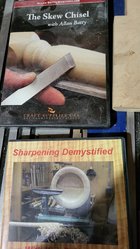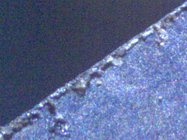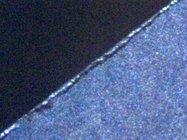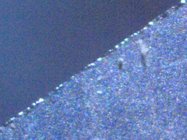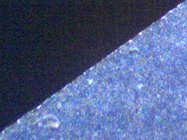I recently purchased my first CBN wheel (180 grit) and a platform jig to sharpen my skew chisels. Both were sharpened at 60 degrees. After the sharpening I have a "blueing" on the long point. Have I ruined the chisel or made it less durable? Need some advice.
-
Beware of Counterfeit Woodturning Tools (click here for details) -
Johnathan Silwones is starting a new AAW chapter, Southern Alleghenies Woodturners, in Johnstown, PA. (click here for details) -
Congratulations to Peter Jacobson for "Red Winged Burl Bowl" being selected as Turning of the Week for April 29, 2024 (click here for details) -
Welcome new registering member. Your username must be your real First and Last name (for example: John Doe). "Screen names" and "handles" are not allowed and your registration will be deleted if you don't use your real name. Also, do not use all caps nor all lower case.
You are using an out of date browser. It may not display this or other websites correctly.
You should upgrade or use an alternative browser.
You should upgrade or use an alternative browser.
Sharpening a skew
- Thread starter Ross Cockfield
- Start date
What kind of steel is your skew made of? Old carbon steel tools would lose their hardness when overheated and the blueing showed up. You would have to carefully grind the edge past the blued area to get to the good steel again.I recently purchased my first CBN wheel (180 grit) and a platform jig to sharpen my skew chisels. Both were sharpened at 60 degrees. After the sharpening I have a "blueing" on the long point. Have I ruined the chisel or made it less durable? Need some advice.
High speed steel isn't as vulnerable to the heat damage. It may lose a little hardness, but still will be usable.
john lucas
AAW Forum Expert
You won't hurt high speed steel at all if you blue it. High carbon steel will lose its hardness and have to be re sharpened often until you grind past that area.
- Joined
- Feb 28, 2021
- Messages
- 1,230
- Likes
- 1,088
- Location
- Roulette, PA
- Website
- www.reallyruralwoodworks.com
What the other 2 said, plus be aware, as I understand it, it is generally not recommended to sharpen high carbon steel on CBN (Not sure why but I think it clogs the wheel?) But I have had no trouble with overheating HSS and M2 and higher grades of HSS - though I try to avoid it. Doug Thompson at Thompson tools has a video where he blatantly overheats the steel on a gouge while grinding a profile... and it does the steel no harm at all
Thanks but they're both HSS. As long as I can continue to work I won't worry about it.What kind of steel is your skew made of? Old carbon steel tools would lose their hardness when overheated and the blueing showed up. You would have to carefully grind the edge past the blued area to get to the good steel again.
High speed steel isn't as vulnerable to the heat damage. It may lose a little hardness, but still will be usable.
Thanks. Just wanted to make sure.You won't hurt high speed steel at all if you blue it. High carbon steel will lose its hardness and have to be re sharpened often until you grind past that area.
I'll look for that video. Thanks.What the other 2 said, plus be aware, as I understand it, it is generally not recommended to sharpen high carbon steel on CBN (Not sure why but I think it clogs the wheel?) But I have had no trouble with overheating HSS and M2 and higher grades of HSS - though I try to avoid it. Doug Thompson at Thompson tools has a video where he blatantly overheats the steel on a gouge while grinding a profile... and it does the steel no harm at all
You won't hurt high speed steel at all if you blue it. High carbon steel will lose its hardness and have to be re sharpened often until you grind past that area.
Agreed, just don't water quench HSS to cool it as that can start micro-cracking on the edge.
john lucas
AAW Forum Expert
You can sharpen carbon steel on a CBN wheel if you buy the slick Stick from Ken Rizza. You need a very light touch to sharpen skews on a grinder using the finer wheels. Don Geiger sells a wheel shaping attachment that makes your gringing wheel surface round. It's the greatest thing in the world for sharpening skews and other flat woodworking tools. Your only heating the tool where the stone touches so your much less likely to overheat the edge.
Hi Ross, with HSS tools, sharpening will not damage it until it gets red hot, blueing will not change the temper.I recently purchased my first CBN wheel (180 grit) and a platform jig to sharpen my skew chisels. Both were sharpened at 60 degrees. After the sharpening I have a "blueing" on the long point. Have I ruined the chisel or made it less durable? Need some advice.
john lucas
AAW Forum Expert
Even red hot probably wont hurt it. HSS was originally designed to get red hot during use and not be damaged. In my research on heat treating HSS it had to be heated to a very high temp within a couple of degrees and remain there for a specific time. It is a complicated and exacting procedure. That's why there is such a variance in the quality of tools. The good companies take the time to donit right. The cheap companies do it much less precisely and thats why less expensive tools may or may not hold an edge.
Even red hot probably wont hurt it. HSS was originally designed to get red hot during use and not be damaged. In my research on heat treating HSS it had to be heated to a very high temp within a couple of degrees and remain there for a specific time. It is a complicated and exacting procedure. That's why there is such a variance in the quality of tools. The good companies take the time to do it right. The cheap companies do it much less precisely and thats why less expensive tools may or may not hold an edge.
M2 tool steels are annealed at approx 885°C (1625°F)
M42 is annealed at approx 850°C – 900°C
PM V10 is annealed at approx 1600 - 1650°F (871 - 899°C)
Having reached those temperatures it then has to be cooled very slowly over an extended time to remain annealed. You have to get above 'full cherry red' to get to those temperatures (see chart below). The small particles of swarf coming off the grinder may get to higher temperatures, but in my experience you are going to have to work very hard to get anything above a blue in the tool itself.
As John points out, some lower quality HSS tools may have been made with poor heat treatment but, as I understand it, you are not going to damage the temper in a HSS tool that was properly heat treated during its manufacture by anything you do yourself on a CBN wheel or sparky.
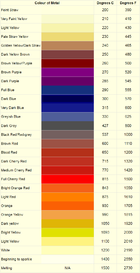

The Color Spectrum of Heated Steel
When heating steel you may notice changes in color on the material (such as in a picture during the bending of this table leg). The Scale Model EXchange have an interesting color spectrum of the va…
 blog.adafruit.com
blog.adafruit.com
Ross, your question about bluing the steel has been ably answered. Regarding your sharpening of the skew, it may be too blunt. The longer and thinner the skew, the smoother the potential cut and the grabbier it will be, and the shorter and blunter the skew is, the tamer but less effective it will be. If you're in the ballpark, the width of the bevel (from edge to unground stock) should be about 1 1/2 X the thickness of the skew. Some people like their skews a little blunter and some like them a little sharper, but this ratio gets you to a good, compromise starting point.
Be sure to hone the grinder burr off on skews - 600 gr or higher, stropping works also. It will cut equally well fromm either side.
I consider stropping to be mandatory for skew chisels. I thought a 1000 grit wheel would make all the difference when using a skew. It didn't. I saw Eric Loffstrom demo, and he started by tapping his skew edge on the lathe bed. He took it to a 60 grit CBN wheel, then stropped it with some cheap black honing/polishing paste on some leather and shaved the hair off of his arm in one pass. I can still feel a burr at 8000 grit. This still happens even with the lightest of pressure applied to the blade.
robo hippy
robo hippy
I did not know this. Is it better to oil quench? Or just let it cool down naturally. Unfortunately, I’m still stuck in the aluminum oxide wheel world, so overheating is all too relevant sometimes.Agreed, just don't water quench HSS to cool it as that can start micro-cracking on the edge.
When I grind HSS tool blanks for my metal lathe I use water to cool then and have never noticed any ill affects.Agreed, just don't water quench HSS to cool it as that can start micro-cracking on the edge.
john lucas
AAW Forum Expert
For many of my early years I grossly overheated my HSS tools. I had a high speed grinder and gray wheel. I would water quench them and keep grinding until o got it right. I never had any problems with crack from the quenching that I could tell. Years later I started seeing the warning not to quench them. Of course my skills improved and i sharpening tools are better. If i do need to cool a tool i just stick it in water. It never hurt my tools before. Oil is not needed. That's for Blacksmiths and certain steels and they know what to use when.
- Joined
- Feb 28, 2021
- Messages
- 1,230
- Likes
- 1,088
- Location
- Roulette, PA
- Website
- www.reallyruralwoodworks.com
I never water quench mine if and when they do get too hot to handle, I just lay them flat on a cold piece of metal, tool rest, vise, or some such - any sort of heat sink can help it cool down. I don't like keeping water laying out in the shop as it eventually gathers sawdust and the container (and sawdust) can grow mold - Too much trouble to pour out some water for quenching when most times it is only a few seconds to sharpen and a few seconds to lay tool on some cold metal to take away a bit of the heat. Often enough just using some tools (especially parting tool) can generate plenty of heat from friction and tool tip gets too hot to touch, so I just don't bother quenching.I did not know this. Is it better to oil quench? Or just let it cool down naturally. Unfortunately, I’m still stuck in the aluminum oxide wheel world, so overheating is all too relevant sometimes.
Once you become well practiced at sharpening your tools, you may find you only have to touch tool to grinding wheel for a second or two if that to get a nice sharp edge.
Good advice. Thanks for the thoughtful response. I guess I’ll have to throw out my old coffee cup with gray water. Only half kidding.I never water quench mine if and when they do get too hot to handle, I just lay them flat on a cold piece of metal, tool rest, vise, or some such - any sort of heat sink can help it cool down. I don't like keeping water laying out in the shop as it eventually gathers sawdust and the container (and sawdust) can grow mold - Too much trouble to pour out some water for quenching when most times it is only a few seconds to sharpen and a few seconds to lay tool on some cold metal to take away a bit of the heat. Often enough just using some tools (especially parting tool) can generate plenty of heat from friction and tool tip gets too hot to touch, so I just don't bother quenching.
Once you become well practiced at sharpening your tools, you may find you only have to touch tool to grinding wheel for a second or two if that to get a nice sharp edge.
I’m definitely better than I used to be, but it’s not quite yet my forte. Though, I just shaped a bowl gouge from traditional into a fingernail profile. It took long enough. I fear if I didn’t quench, I would have been there half the day haha
I never had any problems with crack from the quenching that I could tell.
Good to know, John. I always put more value on years of workshop experience over textbook knowledge.
In theory, water quenches too fast and unevenly, the latter from air bubbles forming as it boils.
Oil quenches slower, but has health issues from the vapours given off and is messy.
However, perhaps the rate at which we re-sharpen may eliminate any micro-cracking as we go before it becomes an issue, anyway...
When I grind HSS tool blanks for my metal lathe I use water to cool them and have never noticed any ill affects.
Good to know, David.
Am I right in thinking that the cutting edge angles used in metal turning are more obtuse than we use in woodturning? If so, that might be a factor.
The cutting edge angles used on knives are usually more acute yet again than we use in woodturning and I know that the knife people are very cautious about de-tempering the thin edges on their blades. As most the cutting angles we use on our woodturning tools are less acute and mostly made from various HSS we don't have to be as cautious as the knife people. They are also using steels that are more prone to over-tempering during grinding and honing.
For anyone who might be interested, the following article provides test results on using the various methods of knife grinding and honing. Unless you are a 'knife knut', the summary at the end is probably sufficient. Note: The grinding systems used for the tests are familiar to us, but none of the knives used were made from the HSS we woodturners mostly use...
This is what a basic set will look like. Bear in mind that a machinist will grind the HSS blank to whatever profile they need to accomplish the cut.Good to know, David.
Am I right in thinking that the cutting edge angles used in metal turning are more obtuse than we use in woodturning? If so, that might be a factor.
The cutting edge angles used on knives are usually more acute yet again than we use in woodturning and I know that the knife people are very cautious about de-tempering the thin edges on their blades. As most the cutting angles we use on our woodturning tools are less acute and mostly made from various HSS we don't have to be as cautious as the knife people. They are also using steels that are more prone to over-tempering during grinding and honing.
For anyone who might be interested, the following article provides test results on using the various methods of knife grinding and honing. Unless you are a 'knife knut', the summary at the end is probably sufficient. Note: The grinding systems used for the tests are familiar to us, but none of the knives used were made from the HSS we woodturners mostly use...
Top view
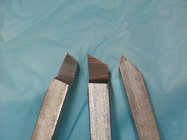
Left side
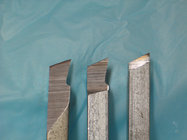
Right side
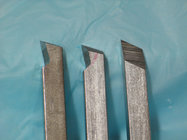
Or you can leave the burr on and use it as a shear scraper as shear scrape was originally conceived. The burr can also be applied with the tool flat on the tool rest with the burr facing up but it usually works best with the tool at about a 45degree angle to the tool rest to change it to a shear cut.Be sure to hone the grinder burr off on skews - 600 gr or higher, stropping works also. It will cut equally well fromm either side.
- Joined
- Apr 27, 2004
- Messages
- 8,652
- Likes
- 5,010
- Location
- Lakeland, Florida
- Website
- www.hockenberywoodturning.com
Unfortunately, I’m still stuck in the aluminum oxide wheel world, so overheating is all too relevant sometimes.
I used A/O wheels for many years.
Dressing the wheels at least once a day keeps them sharpening cooler.
You may have noticed the wheels cut better when newly dressed and sharper quicker with little heat buildup.
The wheels get glazed with use and make more heat because we push harder to get them to work - all this make more heat.
Thanks for the advice. I’m sometimes stingy about dressing because I don’t want to reduce the wheel diameter. I recognize this is “bass-ackwards” thinking. Ha!I used A/O wheels for many years.
Dressing the wheels at least once a day keeps them sharpening cooler.
You may have noticed the wheels cut better when newly dressed and sharper quicker with little heat buildup.
The wheels get glazed with use and make more heat because we push harder to get them to work - all this make more heat.
This is what a basic set will look like. Bear in mind that a machinist will grind the HSS blank to whatever profile they need to accomplish the cut.
Top view
Left side
View attachment 46888
David
Thanks for those photos. So, about a 70° edge angle.
Some turners go as obtuse as that for their bottom inside of bowl gouges, so you have one reference point there with quenching and HSS.
You will of course take your skew to a more acute angle, perhaps to something more like half of that edge angle. If I was working with an edge as acute as that and was inclined to quench (I wouldn't myself as I'm not concerned about over/de-tempering of HSS) I would check for any sign of micro-cracking with a USB scope (like one of these). But, as previously said, perhaps we woodturners regrind so frequently that any micro-cracking that might happen will be removed with subsequent regrinding before it becomes an issue.
On understanding sharpening techniques, I recommend to anyone who is doing any amount of sharpening to get some form of magnification to see what is really happening at the cutting edge. You can't see that in sufficient detail with the naked eye or feel it with the finger, or shave your arm to know how long an edge might last. Most of the time a jewellers loup is sufficient for me to see what is going on, but one of the above mentioned USB scopes will provide more detail and a means of recording outcomes. I do a lot of sharpening of edges on many different types of tool and I find some form of magnification indispensable for the analysis of problems and the refining of sharpening techniques.
For example, the mag images of the burr off two different grit size wheels provide an indication of how the burr will last and the finish you are likely to get off both...
Last edited:
Maybe I am the only one but I prefer a flat ground surface for the bevel of my skew chisels so I use my belt sander and 120 grit.
Mostly use skews for doing spindle turnings on flutes.
Mostly use skews for doing spindle turnings on flutes.
This might be opening up a can of worms regarding hollow ground vs flat ground, but do you prefer flat grinding so you can ride the bevel more easily?Maybe I am the only one but I prefer a flat ground surface for the bevel of my skew chisels so I use my belt sander and 120 grit.
Mostly use skews for doing spindle turnings on flutes.
Michael, yes, I feel I get a cleaner cut, especially in figured and knotty portions.This might be opening up a can of worms regarding hollow ground vs flat ground, but do you prefer flat grinding so you can ride the bevel more easily?
- Joined
- Apr 27, 2004
- Messages
- 8,652
- Likes
- 5,010
- Location
- Lakeland, Florida
- Website
- www.hockenberywoodturning.com
I view it as sort of nuance. Not a can of worms but no right answer…This might be opening up a can of worms regarding hollow ground vs flat ground, but do you prefer flat grinding so you can ride the bevel more easily?
Also a trade off.
With skew honing a hollow ground bevel is almost fool proof
I sharpen my spindle gouges on a grinding wheel without a jig so I get a slightly convex bevel.
A convex bevel is easier for most people to control.
In classes Jimmy Clewes will put a convex grind on skews for students who keep making spirals. Students are much more successful when given the convex bevel to use.
I rarely grind skews. i usually sharpen skews with Arkansas stones to a flat bevel and hone.
A honed skew will have a flat micro bevel which is easy to “ride”
A convex bevel has a micro bevel by design
The flat bevel gives great control finishing a cylinder
In turning a bead the three bevels are about the same.
Last edited:
Great information. Thank you so much. I’ve never thought about putting a convex grind on the skew. I can see how that would prevent catches when doing detail work. Though, it seems like that would impair you when planing?
That said, I can see the benefits of all grinds. Maybe we should just have an arsenal of skews with different angles, sizes, and grinds. Some with microbevels, some without. And then an oval version of each. Kidding, sort of. Haha
That said, I can see the benefits of all grinds. Maybe we should just have an arsenal of skews with different angles, sizes, and grinds. Some with microbevels, some without. And then an oval version of each. Kidding, sort of. Haha
john lucas
AAW Forum Expert
I tried all the grinds to learn the difference. For all.practical purposes there is such a subtle difference between the grinds. I worked with a ton of skews for 2 years. What I learned is whatever skew you practice with long enough will work fine for you no matter what the grind. I didnt find one to be superior to any other. Some did work a little better for some cuts but not as good for others. Here is my video.
View: https://youtu.be/YFlZyGKYro4
I finally got it thru my head after years of listening to a good friend: grindstones are like brake pads or sandpaper. They are shop consumables.Thanks for the advice. I’m sometimes stingy about dressing because I don’t want to reduce the wheel diameter. I recognize this is “bass-ackwards” thinking. Ha!
I have one skew that I keep with a convex grind. I do find it to be a bit more user friendly, especially since I don't use them that much. Learned it from Eli Avesera. I do find it a bit more challenging to get a straight line cut, but easier to make slight curves.
robo hippy
robo hippy
Great way to think about it.I finally got it thru my head after years of listening to a good friend: grindstones are like brake pads or sandpaper. They are shop consumables.
And thanks @john lucas that video was interesting. I’m also able to see I’ve witness the world’s smallest skew. Woah!
john lucas
AAW Forum Expert
I dont know if my smallest skew is in that video. I have one made from .008" piano wire. That one may be .012". On my smallest goblets the stem was less tan .012" long so needed a smaller skew to properly shape it.
odie
TOTW Team
- Joined
- Dec 22, 2006
- Messages
- 7,123
- Likes
- 9,887
Question:
Are most everyone using straight ground skews.....or, is anyone using the curved skews that Richard Raffan demonstrates with?
Even though I'm pretty much a dedicated bowl turner, and don't do spindles very often, I'm using the curved Raffan style skews. I've found that the skew jig sold for the Wolverine system does a nice job with the curved skews.
As with my gouges, I hand hone the edge.
-----odie-----
Are most everyone using straight ground skews.....or, is anyone using the curved skews that Richard Raffan demonstrates with?
Even though I'm pretty much a dedicated bowl turner, and don't do spindles very often, I'm using the curved Raffan style skews. I've found that the skew jig sold for the Wolverine system does a nice job with the curved skews.
As with my gouges, I hand hone the edge.
-----odie-----
Last edited:
- Joined
- Feb 28, 2021
- Messages
- 1,230
- Likes
- 1,088
- Location
- Roulette, PA
- Website
- www.reallyruralwoodworks.com
Not sure what you mean by curved skew, but if it is what I think it is, all mine are "modifying" as I sharpen them from being straight across ( at the usual angle, from toe to heel) to having more of a curve towards the heel edge because of how I've been sharpening them - which I find much easier to get a consistent edge (start with toe at the correct angle and then just guide a finger along the rest while pivoting to the heel- works far better than when I tried to guide it straight across with both hands.... ) I find that grind seems to be easier to use (and master) with much less catching, at least for me.Question:
Are most everyone using straight ground skews.....or, is anyone using the curved skews that Richard Raffan demonstrates with?
Even though I'm pretty much a dedicated bowl turner, and don't do spindles very often, I'm using the curved Raffan style skews. I've found that the skew jig sold for the Wolverine system does a nice job with the curved skews.
As with my gouges, I hand hone the edge.
-----odie-----

